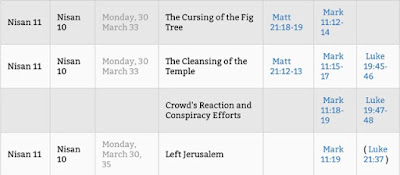Yesterday, Palm Sunday, was the triumphal entry by Jesus into Jerusalem. In some commentaries, it makes note of Jesus looking into the temple to gauge the level of work he had to do the next day. A scout trip, perhaps. I certainly find it plausible, and looking through the gospels at the events, I've also found a lot of confusion in the chronology. However, after checking out the temple, He spent the night in Bethany and we are going to pick it up on Monday morning.
There were some significant events occurring on Monday. By all accounts, it was a strategic and busy day. And it started with Jesus cursing the fig tree. Why?
The FaithLife Study Bible commentary gives us an indication:
From the Faithlife Study Bible:
- Cursing of the Fig Tree (Mt 21:18-19)
The fig tree is also symbollic of Israel itself – It often symbolized the health of the nation both spiritually and physically [1]. Hosea 9:10 says,“When I found Israel, it was like finding grapes in the desert; when I saw your ancestors, it was like seeing the early fruit on the fig tree.”Later, the Bible tells us of the glorious time when“Judah and Israel lived in safety, every man under his vine and his fig tree, from Dan even to Beersheba, all the days of Solomon.” (1 Kings 4:25)Later still, following the minor prophets we can see warnings to the nation of how God would bring destruction and failure of crops as part of his judgement against them, specifying empty fig trees that were stripped bare and fruitless. (Joel, Habakkuk and Haggai)It’s almost as if the fig was something of a barometer of the health of the nation – taken away as punishment, and flourishing in times of restoration. From Symbolism of Figs One With Israel
Jerusalem’s leaders failed to properly welcome Jesus as a visiting dignitary into their city during the Passover festivities (see v. 10 and note). Consequently, when He re-enters Jerusalem the following morning, He pronounces a curse on a barren fig tree as a symbolic act of judgment against the city and its leaders. Matthew 23:37–24:2 elaborates on this judgment.
- Jesus Cleans Out the Temple For ver. 45–47, see Matt. 21:12–16; Mark 11:15–19; John 2:14–16 Did he do this twice?
Mark, however, used more detailed, chronological language. On the first day, Jesus went into Jerusalem and the temple (Mark 11:1-11), then later that day He and His apostles departed for Bethany. “Now the next day, when they had come out of Bethany” (11:12, emp. added), Jesus again went into Jerusalem and into the temple. Unlike His trip to the temple the previous day, this time Jesus entered the temple “to drive out those who bought and sold in the temple” (Mark 11:15-18). Thus, Jesus actually made two trips to the temple: once on the day of His triumphal entry (Mark 11:11), then again “the next day” to cleanse the temple (Mark 11:12,15-18). In this instance, Mark’s account is more sequential, while Matthew’s is more of a summary.The reaction of the crowd found in Mk 11:18-19 is telling. They're convicted and when a man is under conviction, their rage usually starts with God. (Proverbs 19:3).
From the Faithlife Study Bible:
The popular acclamation of Jesus as the “Son of David,” combined with His forcible occupation of the temple courts, gave these priests ample reason to destroy Him. This reaction parallels that of the Pharisees in Galilee.Jesus leaves Jerusalem and heads back to Bethany with the Twelve and some speculation he stayed with Lazarus, Mary, & Martha that night.
A long day, to be sure. A longer one is coming tomorrow...



No comments:
Post a Comment